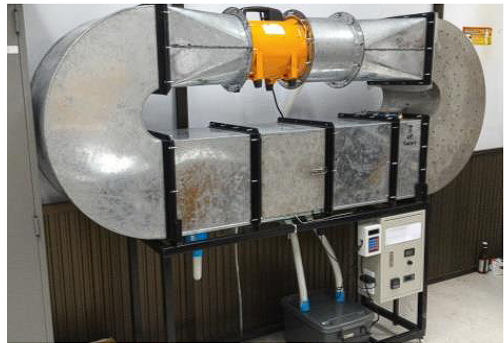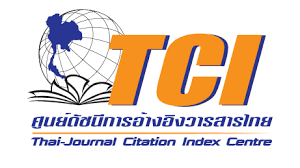Drying Kinetics of House Cricket by Hot Air Drying using Full Air Re-circulation Tunnel under Varying Temperatures and Air Velocities
doi: 10.14456/mijet.2023.6
Keywords:
house cricket, thin layer drying, mathematical model, activation energyAbstract
House cricket is a kind of insect to be used as an alternative protein source to create a new food in the present because of its high yield protein content therefore there are a lot of cricket farm was established for new economics in Thailand. The cricket was processed into easy food by frying or more technology to be cricket power and pasta. However, cricket must be dried and easy method for small scale is hot air drying by solar or in hot air oven. Therefore, this paper aims to kinetic study of thin layer drying of house cricket by hot air in 60, 70, and 80°C varying with 1.0, 1.5, and 2.0 m/s. Six semi-theoretical model were used to describe the experiment having confirm the best model by statistic values includes R2, c2, and RMSE. The experimental result was shown that the Midilli drying model is the best fit of thin layer drying of cricket for all temperature and air velocity. The effective moisture diffusivity was obtained in ranged between 4.78×10-9 and 1.31×10-8 m2/s for all experiment. The activation energy of diffusion of cricket is 30.74 – 41.73 kJ/mol which is in the normal range of food materials. Predicted moisture ratio agreed well with experimental values.
References
A.V. Huis, J.V. Itterbeeck, H. Klunder, E. Mertens, A. Halloran, G. Muir, and P. Vantomme, “Edible Insects: Future Prospects for Food and Feed Security,” FAO Forestry paper 171, Rome, Italy, 2013. [Online]. Available: http://www.fao.org/3/i3253e/i3253e.pdf [Accessed 9 June 2022].
J. Mlcek, O. Rop, M. Borkovcova, and M. Bedarova, “A comprehensive look at the possibilities of edible insects as food in Europe–a review,” Polish Journal of Food and Nutrition Science, vol. 64, no. 3, pp.147–157, 2014.
V. Nowak, D. Persijn, D. Rittenschober, and U.R. Charrondiere, “Review of food composition data for edible insects,” Food Chem, vol.193, pp. 39–46, 2016.
R.L. Whistler, “Industrial Gums: Polysaccharides and Their Derivatives,” Academic Press, pp. 601–604, 1993.
M.A. Ayieko, H.J. Ogola, I.A. Ayieko, 2016. Introducing rearing crickets (gryllids) at household levels: Adoption, processing, and nutritional values. Journal of Insects as Food and Feed, 2(3), 203–211.
V. J. Stull, E. Finer, R.S. Bergmans, H.P. Febvre, C. Longhurst, D.K. Manter, and T.L. Weir, “Impact of edible cricket consumption on gut microbiota in healthy adults, a double-blind, randomized crossover trial,” Scientific Reports, vol. 8, 10762, 2018.
A. Midilli, and H. Kucuk, “Mathematical modelling of thin layer drying of pistachio by using solar energy,” Energy Conversion and Management, vol.44, pp.1111-1112, 2003.
E.K. Akpinar, Y. Bicer, and F. Centikaya, “Modelling of thin layer drying of parsley leaves in a convective dryer and under open sun,” Journal of Food Engineering, vol.75, pp.308-315, 2006.
E. K. Akpinar. “Mathematical modelling and experimental investigation on sun and solar drying of white mulberry,” Journal of Mechanical Science and Technology, vol. 22, pp.1544–1553, 2008.
J. Crank, “The Mathematics of Diffusion,” Clarendon Press, second edition, pp 89-91, 1975.
M. Peter, Z. Liu, Y. Fang, X. Dou, E. Awuah, S.A. Soomro, and K. Chen, “Computational intelligence and mathematical modelling in chanterelle mushrooms’ drying process under heat pump dryer,” Biosystems Engineering, vol. 212, pp. 143-159, 2021.
A.O. Omolola, P.F. Kapila, and H.M. Silungwe, “Mathematical modeling of drying characteristics of Jew’s mallow (Corchorus olitorius) leaves,” Information processing in agriculture, vol. 6, pp. 109 – 115, 2019.
O.R. Alara, N.H. Abdurahman, and O.A. Olalere, “Mathematical modelling and morphological properties of thin layer oven drying of Vernonia amygdalina leaves,” Journal of the Saudi Society of Agricultural Sciences, vol. 18, pp. 309-315, 2019.
W.B. Asiru, A.O. Raji, J.C. Igbeka, and G.N. Elemo, “Mathematical Modelling of Thin Layer Dried Cashew Kernels,” Official Journal of Nigerian Institute of Food Science and Technology, vol. 31, No. 2, pp. 106 – 112, 2013.
W.P. da Silva, C.M.D.P.S. e Silva, F. J.A. Gama, and J.P. Gomes, “Mathematical models to describe thin-layer drying and to determine drying rate of whole bananas,” Journal of the Saudi Society of Agricultural Sciences, vol. 13, pp. 67-74, 2014.
N.T. Tran, K.S. Khoo, K.W. Chew, T.Q. Phan, H.S. Nguyen, T.NG. Sy, T.D.P. Nguyen, W.Hs. Chen, P.L. Show, 2020. Modelling drying kinetic of oyster mushroom dehydration – The optimization of drying conditions for dehydration of Pleurotus species. Materials Science for Energy Technologies, vol. 3, pp. 840-845.
A. Koukouch, A. Idlimam, M. Asbik, B. Sarh, B. Izrar, A. Bah, and O. Ansari, “Thermophysical characterization and mathematical modeling of convective solar drying of raw olive pomace,” Energy Conversion and Management, vol. 99, pp. 221-230, 2015.
C. Hermana, L. Spreutels, N. Turomzsac, E. M. Konagano, and B. Haut, “Convective drying of fermented Amazonian cocoa beans (Theobroma cacao var. Forasteiro). Experiments and mathematical modeling,” Food and Bioproducts Processing, vol. 108, pp. 81-94, 2018.
N. Nasathit, S. Sala-ngam, L. Terzieva, C. Photong, “Low-cost herb dryer using infrared lamps with circulating hot air blowers,” Engineering Access, vol. 9, no. 1, pp. 47-55, 2023.
P. Thiangma, W. Nakbanpote, N. Poomsa-ad, L. Wiset, “Effect of drying condition on Shatavari (Asparagus racemosus Willd) root quality and energy consumption,” Engineering Access, vol.8, no. 2, pp. 330-335, 2022.

Downloads
Published
How to Cite
Issue
Section
License

This work is licensed under a Creative Commons Attribution-NonCommercial-NoDerivatives 4.0 International License.








